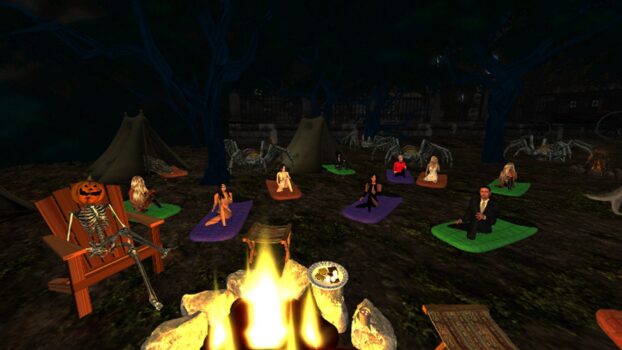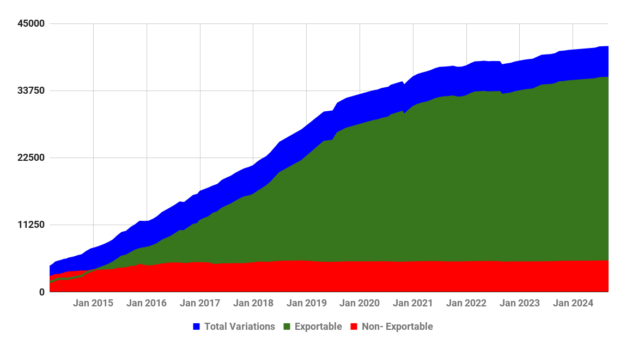11 Metaverse Use cases and Benefits in 2024
As exponential technologies continue to converge, visions of a fully immersive virtual world called the Metaverse have captured the imagination of innovators and businesses alike. From fiction becoming reality through innovations like virtual reality (VR), augmented reality (AR), and artificial intelligence (AI), the Metaverse promises to fundamentally reshape how we learn, work, play, and live by blurring the lines between physical and digital worlds. This blog will explain various benefits and use cases of the metaverse.
The Metaverse refers to a future state of the Internet where physical and digital worlds converge entirely through emerging technologies. It envisions a fully immersive 3D virtual universe populated by our avatars. They act and interact just like we do in the physical world. In the Metaverse, we will shop, attend parties and meetings, explore places and spaces, watch movies, and play games. We essentially live our whole virtual lives alongside our physical ones. And we’ll do this through augmented and virtual reality interfaces that make everything feel real. The Metaverse also promises a merging of realities that enables new levels of human connection, creativity, and productivity. It is free from the limitations of time, distance, and even physical bodies.
The Metaverse presents companies with a once-in-a-lifetime opportunity to reimagine how they relate to customers in this new 3D virtual reality. Entire business models built around physical interaction and real-world presence will be upended as people spend more time in virtual spaces. Companies understand how to leverage the Metaverse’s potential for immersion, interactivity, and persistence. These companies will gain huge advantages over those that remain hesitant or ignore it altogether.
Every aspect of a firm’s value chain from marketing to sales, customer service to collaboration will be revolutionized. This will be achieved as the Metaverse makes experiences the new currency of business success. But responsibly navigating this transformation will be key. Businesses must also learn to operate with empathy in virtual environments that mirror. It also magnifies issues of privacy, inequality, and opacity in the physical world. Those able to harness the Metaverse’s powers for good will emerge as the winning organizations of the future.
The metaverse has emerged as a transformative concept with immense potential across various industries. By blending physical and digital realities, the metaverse offers a virtual landscape where individuals can interact, collaborate, and explore immersive experiences.
Beyond its applications in gaming and entertainment, the metaverse is increasingly being adopted by diverse sectors to revolutionize their operations and create new opportunities. Here are some potential Metaverse use cases in various industries:
1. Gaming
Gaming companies are leading the way in building immersive Metaverse-like virtual worlds. The Metaverse promises to evolve gaming by enabling seamless continuity between titles through avatars and virtual item ownership. It helps blur the lines between individual games and create a unified virtual gaming experience. For gamers, this also represents truly digital life where every game is simply a new universe to explore.
2. Travel and Tourism
The Metaverse represents a huge opportunity for the travel industry to offer immersive virtual experiences that go beyond traditional photos and videos. Travel agencies can leverage 3D recreations of destinations for potential visitors to tour virtually through their avatars. Tourists can also use augmented reality applications during actual trips for hyper-realistic, enhanced experiences. Ultimately, the Metaverse also promises to make travel marketing more interactive and virtual trips more memorable.
3. Education and Learning
The Metaverse has immense potential to revolutionize education by making learning more interactive and immersive through virtual classrooms, 3D simulations, and interactions with avatar teachers. Students will be able to attend lessons anytime, anywhere, and interact with simulated environments that bring concepts to life. The Metaverse also promises to transform education into a truly digital experience that frees it from the constraints of physical locations.
4. Remote working
The Metaverse presents an enormous opportunity to reimagine how people work remotely. Office workers of the future may meet with colleagues as avatars in virtual meeting rooms and collaborate on 3D projects together. They can also access virtual versions of physical workspaces. If done right, the Metaverse also has the potential to make remote teams feel more present, connected, and productive. This will be done with a fully immersive virtual format that transcends the limitations of today’s 2D video conferencing.
5. Real estate
The Metaverse represents huge potential for the real estate industry by providing immersive virtual experiences that complement physical spaces. Property buyers could tour virtual recreations of homes before visiting in person to gain a realistic sense of different options. Real estate agents could utilize avatar representatives to give potential clients virtual walkthroughs of listings. Ultimately, the Metaverse may also transform how people visualize, interact with, and buy physical real estate in the years ahead.
6. Healthcare
The Metaverse holds immense promise to revolutionize how healthcare is delivered and received through virtual technologies. Doctors could conduct remote consultations, perform surgeries using VR/AR, and provide virtual therapies accessed through avatars. Medical training could also be transformed through immersive simulations. If realized responsibly, the Metaverse has the potential to make healthcare more accessible, affordable, and effective. This will be achieved through virtual interactions that transcend the barriers of physical location.
7. Banking and Finance
The Metaverse could upend traditional banking models through innovative applications. These include virtual bank branches staffed by AI avatars, cryptocurrency wallets linked to users’ digital identities, and immersive financial literacy programs. It will make learning fun through games and simulations. Banks that embrace these possibilities first stand to reshape the customer experience and unlock new paths for growth.
8. Social media and entertainment
The Metaverse will transform social media and entertainment by enabling users to interact in unprecedented ways through their digital avatars. Creators will be able to build entire virtual worlds branded around their personalities. Fans will be able to participate in immersive concerts and experiences, collect virtual merch, and interact directly with their favorite celebrities and influencers. The Metaverse promises to take fan engagement and immersion to an entirely new level.
9. Retail and E-commerce
Metaverse technology is reshaping the retail and e-commerce landscape by creating virtual stores, marketplaces, and shopping experiences. Customers can browse and purchase virtual products, try on virtual clothing, and even create virtual avatars that reflect their style. This immersive shopping experience enhances convenience, personalization, and engagement for consumers.
10. Workplace Collaboration
The metaverse provides virtual workspaces that foster remote collaboration and teamwork. Companies can conduct virtual meetings, host interactive presentations, and collaborate on projects in real-time. This use case breaks down geographical barriers, promotes productivity, and creates dynamic work environments.
11. Art and Creative Industries
For artists and creators, the metaverse offers a canvas for showcasing their work and engaging with audiences in unique ways. Artists can exhibit virtual galleries, collaborate on immersive digital artworks, and offer virtual art experiences. This use case expands the boundaries of creativity, enables new art forms, and connects artists with global audiences. It is the most advanced metaverse used in real life.
The metaverse is a transformative force that holds incredible potential across diverse industries. From gaming and entertainment to education, healthcare, retail, and beyond, the metaverse is reshaping how we interact, learn, work, and experience digital environments. These all metaverse use cases represent just a glimpse of the possibilities that the metaverse offers, and as technology continues to advance, we can expect even more innovative applications in the future. Embrace the metaverse revolution and get ready to explore a new dimension of possibilities.
The Metaverse offers a multitude of benefits for businesses, revolutionizing the way they operate and interact with customers. Here are some key advantages of metaverse for businesses:
1. Engaged users
One of the most significant Metaverse benefits for businesses will be the ability to fully capture users’ attention through complete sensory immersion. Within virtual worlds, customers will be able to touch, feel, and manipulate products in realistic 3D form.
They can interact naturally with virtual brand representatives and attend engaging events hosted by companies. Studies show people retain 95% of experiences compared to just 10% of passive content. As a result, businesses can translate their real-world offerings into immersive and interactive experiences within the Metaverse. It will gain devoted customers with unprecedented levels of brand loyalty, advocacy, and spending potential.
2. Virtual event opportunities
Metaverse applications for businesses will be the ability to host large-scale immersive virtual events that drastically improve attendee engagement. Unlike traditional webinars and virtual conferences, Metaverse events can transport participants to innovative digital environments. They can also mingle with realistic avatars, visit interactive exhibition booths, attend sessions in virtual auditoriums, and explore content together.
This level of immersion and social presence promises to generate much higher rates of attendee attention, participation, knowledge retention, and network-building. As a result, businesses can harness the Metaverse’s strengths to reimagine how they connect with audiences through virtual events. It will also gain an enduring competitive advantage in the form of deeper relationships with customers, partners, and employees.
3. Sell and showcase products
The Metaverse offers huge potential for businesses to sell and showcase products in immersive virtual spaces. Companies can create virtual storefronts within Metaverse platforms where potential customers navigate aisles and interact with product demonstrations using their avatars. This also allows consumers a more sensory-rich virtual shopping experience that closely mimics real life, potentially driving higher engagement, conversion rates, and sales.
The Metaverse may also enable businesses to test unbuilt products before investing in physical prototypes through realistic virtual replicas. It will help showcase the power of truly immersive commerce that transcends the limitations of e-commerce websites to bring the physical. It will also make the digital shopping experience closer together than ever before.
4. Innovative advertising
One of the greatest Metaverse benefits for businesses will be the ability to create immersive and interactive advertising experiences that command users’ undivided attention. Brands will be able to embed themselves into virtual worlds through interactive ads, sponsored virtual spaces, 3D brand logos, and virtual brand ambassadors. This promise of spatial, real-time, and highly contextualized advertising represents a dramatic shift from the interruptive banner ads of today’s 2D internet.
5. Easy transactions
The Metaverse has the potential to revolutionize how businesses transact with customers by making payments simplified and seamless. Users will be able to make purchases directly from within Metaverse platforms using virtual wallets, bypassing the need for traditional payment gateways. This simplified transaction process has the potential to significantly reduce payment friction and boost conversion rates.
The underlying crypto technologies powering Metaverse economies will also enable new forms of micropayments for virtual goods and services. Together, these easier transactions have the power to unlock novel monetization opportunities for businesses as the spatial virtual economy of the Metaverse grows increasingly sophisticated and seamless.
Join us in shaping the future of digital experiences. Together, we can unlock the full potential of the metaverse and create innovative solutions that revolutionize industries and enhance human interaction.
Vegavid Metaverse development company services
The promising use cases highlighted in this article like education, collaboration, gaming, and more will continue to evolve and see increased adoption next year. As metaverse platforms and technologies advance further, the experiences will start feeling closer and closer to reality across different devices. This will drive even greater engagement with these virtual worlds for both work and play. Standards and the ability to transition between platforms seamlessly will also improve, allowing our avatars and digital items to move more fluidly. With enhancements in edge computing, interactions will feel instantaneous with minimal lag.
Integration of artificial intelligence into the metaverse will help augment and enhance our experiences. More industries beyond just tech and gaming will experiment with extended reality for their operations as well. The immersive web will also help connect these virtual spaces more seamlessly.
By 2024, the metaverse should start transforming how entire enterprises conduct business and how communities interact on a global scale. With rising immersion in these collaborative 3D digital worlds, our idea of communication and collaboration is poised to evolve significantly. While challenges remain around aspects like safety, governance, and accessibility – the building blocks are being put in place for the metaverse to make an even bigger impact in the year ahead. Exciting times ahead as we explore new possibilities in the virtual realms!
Conclusion
The Metaverse promises a radical transformation of how people work, learn, socialize, and consume. For businesses, it represents an opportunity to move beyond interruptive 2D marketing and transactional customer relationships into a new realm of interactive storytelling, experiential brand building, and total sensory immersion. By translating their offerings into compelling narratives within immersive virtual worlds, companies that enter the Metaverse early stand to gain devoted brand loyalists and advocates. The Metaverse also promises to usher in a new golden age of innovation as businesses and consumers alike explore what it truly means to bring the virtual and physical worlds together in harmonious and humanity-enriching ways.
















































 And thinking that, how this space can be out October if the Whiteboard support is coming out November..
And thinking that, how this space can be out October if the Whiteboard support is coming out November.. 



